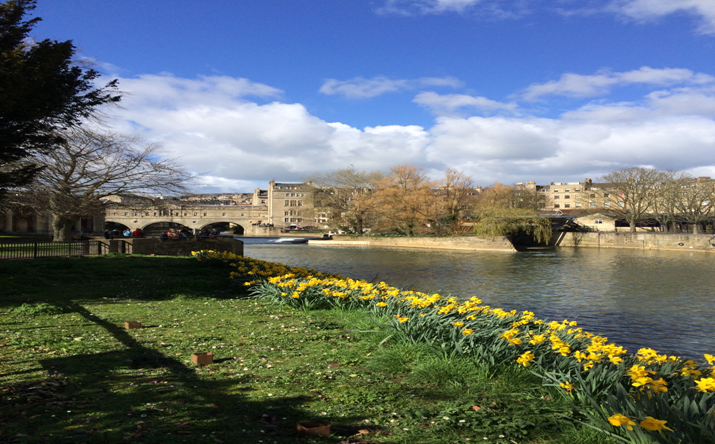For this post, I’m handing over the reigns to Paddy Brian, a passionate historian, who is fresh from his latest trip – a weekend in Bath.
If you have not yet had the opportunity to visit Bath, but have heard people talk about its’ virtues as a city of natural beauty, outstanding architecture and celebrated history, you will not be disappointed. It is all these things, and more.
The first thing that strikes you when you arrive in Bath is its geography. Nestled in the valley of the river Avon, on the periphery of the Cotswolds Hills, it’s easy to see how the city gained its reputation for charm and beauty, you will be hard-pressed to find a more picturesque location anywhere in the world.
In keeping with the city’s earthy endowments, the manmade efforts are no less spectacular. Once you enter the heart of the city, the uniformity of the golden Georgian-era buildings gives you the sense that you are stepping back in time; only the absence of horse-drawn carriages keeps you planted in the 21st century. The most well known example of Bath’s stunning architecture is the ‘Royal Crescent’, a long, semi-circled terraced overlooking a small green, packed with students and dog walkers.
But if you’re like me you’ll find the Coliseum -inspired ‘Circus’, with its ornate frieze, much more appealing. Even newly built homes and the ultra-modern high street shops remain in keeping with the Georgian style without appearing artificial.
For any budding Classicists living or travelling in Britain, Bath is a must visit. In the city centre, surrounded by all the trappings of modernity, is quite simply one of the finest Ancient Roman sites anywhere in the world. The ubiquitous pictures and postcards of the large Roman pool and terrace do not do the site justice. Only when you get underground, wielding an excellent (and free) audio guide, do you really get a sense of just how big the Roman Baths are.
The tour takes you deep under the city into an ancient spa complete with plunge pool, sauna and steam rooms. Throughout the bath complex there are plenty of informative exhibitions, which combined with the audio guide, allow you to explore at your own pace taking in as much (or as little) history as you like.
After a visit to the Roman Baths, and perhaps a pop to the adjacent Italian gelato shop, it is well worth heading into Bath Abbey. Although less popular than its Roman neighbour, it is no less imposing. Inside it offers a bit of peace and quiet, especially when the streets fill up around lunch time. Even if you get round it during the day, the haunting beauty of the Abbey’s gothic features make it a prime attraction in the hours of darkness, and provide a wonderful subject for some night time photography.
Despite its popular tourist character, Bath is a surprisingly inexpensive city when it comes to food and drink. There are plenty of independent coffee shops and tea houses, to compete with the recognized high street brands, which offer affordable settings to rest between activities. Alongside the traditional British pub grub, there is, for reasons unknown to me (not that I’m complaining!), a smorgasbord of high quality, lost priced, Thai restaurants and sushi bars which gives the city a more cosmopolitan feel and allows you to hit the town without breaking the bank.
Bath really does offer something for everyone, with the looks a city from a time gone by and a pristine surrounding countryside, but which processes its own unique and vibrant character than can compete with any of the major cities in the country.
I just hope, unlike me, it doesn’t take you 24 years to pay it a visit.

